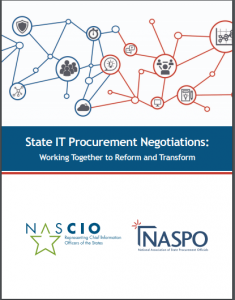Ahead of its annual conference Oct. 1-4 in Austin, Texas, the National Association of State Chief Information Officers (NASCIO), along with the National Association of State Procurement Officials (NASPO), released a road map advocating for state IT procurement reform.
 Earlier this year, NASCIO and NASPO formed a joint task force on IT procurement negotiations, which was co-chaired by Sarah Hilderbrand, Idaho’s chief procurement officer (CPO), and Jim Smith, Maine’s CIO. The task force also included CIOs and CPOs from 15 states. Before developing their recommendations, the task force surveyed CIOs and CPOs from across the country.
Earlier this year, NASCIO and NASPO formed a joint task force on IT procurement negotiations, which was co-chaired by Sarah Hilderbrand, Idaho’s chief procurement officer (CPO), and Jim Smith, Maine’s CIO. The task force also included CIOs and CPOs from 15 states. Before developing their recommendations, the task force surveyed CIOs and CPOs from across the country.
Forty states responded to the survey and the results helped shaped the task force’s mission. For instance, while the majority of states felt their procurement and negotiations process was effective at saving the state money, the majority of states did not feel their current process was helping secure the best and most innovative technology. Additionally, for states that currently negotiate in the IT procurement process, only 6 percent of CIOs and CPOs were involved in shaping the codes, statutes, or legislative policies that govern IT procurement negotiations. Based on the survey results the joint task force felt there was significant room for improvement in the negotiation process, as well as deeper collaboration between CIOs and CPOs.
“The business models in state government IT are changing as rapidly as technology itself. The procurement processes for technology must also adapt,” said Mark Raymond, NASCIO president and CIO for the State of Connecticut. “Indeed, it is our hope that this publication and recommendations help CIOs and CPOs start a conversation about what is to come in this arena.”
Following the survey, the task force developed 18 IT procurement improvement recommendations broken into four categories.
Relationships Matter:
- Base communication and interaction on the assumption that the other party has the best intentions and is working in the best interest of the state. Ensure that there is clear communication among all staffing levels.
- Cross-educate and train to ensure that everyone involved in the IT procurement process is aware of the expertise and value brought to the table by all parties.
- Clearly define roles and responsibilities, identify and address key challenges in the IT procurement process, and collaborate to proactively plan and streamline each IT procurement.
Centralization of IT Procurement
- Centralize the IT procurement management process under one umbrella to increase and leverage the state’s buying power; save the state time and money; and ensure clarity in roles, responsibilities and best practices.
- Don’t focus on who “owns” IT procurement; rather, focus on having the tools needed for successful IT procurements.
- Use centralization of IT procurement to increase awareness and visibility and to maintain and strengthen subject matter expertise in the state’s enterprise architecture.
- Remain or become aligned with the state’s enterprise standards and architecture-driven technology plan.
- Use centralized IT procurement for better vendor management, metrics and performance—all of which contribute to improved negotiations, streamlined terms and conditions, and cost savings for the state.
Procurement Process Partnerships
- Cross-educate CIO and CPO teams and appreciate the perspectives of both teams to ensure an
understanding of priorities and objectives, defined roles, and shared terminology. - Establish a central point of contact in both CPO and CIO offices to promote better communication
and workflow. - At the beginning of the procurement process, determine if it is permissible to negotiate and, if so,
when and what to negotiate. - Work with all parties—including those from the private sector—to establish a process that increases flexibility and communication.
- Craft RFIs and RFPs in a manner that encourages solutions from the private sector rather than focusing on overly prescriptive specifications.
- Use iterative/non-waterfall procurement methodologies when appropriate to improve procurement cycles, add flexibility and reduce risk.
Strategies for Policy and Legislation
- Work together to achieve executive action and legislative authority to allow negotiations to benefit
the state and provide best value for all IT procurements. - Leverage cooperative purchasing, master service agreements and pre-qualified vendor pools, when
appropriate, to achieve the best value for state IT procurements. - Be flexible, but maintain consistency when interpreting internal policy and procurement code to
promote a culture of innovation while balancing risk. - Explore small-scale IT procurement negotiations to build the case for widespread adoption.
In the full report, CIOs and CPOs can also view the task force’s suggested implementation methods. Click here to view the full report.
Check back next week for MeriTalk State & Local’s full coverage of the NASCIO 2017 Annual Conference.
